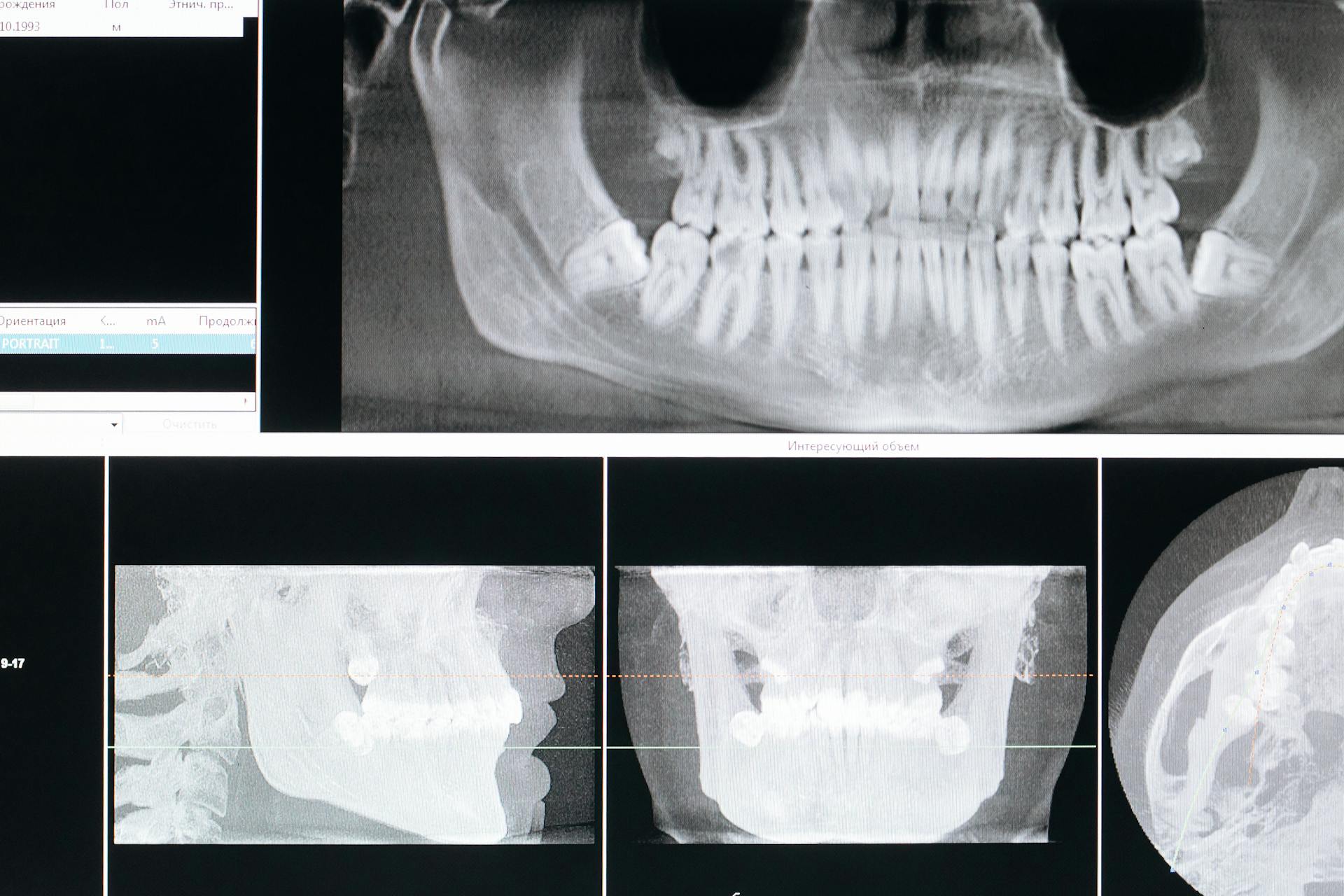
Canine mouth cancer can be a devastating diagnosis for any pet owner, but understanding the life expectancy and prognosis can help you make informed decisions about your dog's care.
The life expectancy of a dog with mouth cancer varies depending on the type and stage of the cancer. For example, squamous cell carcinoma, a common type of mouth cancer in dogs, typically has a poorer prognosis than others.
The prognosis for canine mouth cancer is often influenced by the location and size of the tumor. Tumors located in the tongue or lips tend to have a better prognosis than those in the oral cavity or tonsils.
Treatment options and the dog's overall health can also impact life expectancy. For instance, dogs that receive surgery or radiation therapy may have a better outcome than those that don't receive treatment.
Recommended read: Canine Leishmaniasis Treatment
Causes and Symptoms
Mouth cancer in dogs can be a silent killer, with no identifiable cause in most cases.
The most common types of oral cancers in dogs are melanoma, squamous cell carcinoma, and fibrosarcoma.
These cancers can produce similar symptoms, including excessive drooling, bad breath, difficulty chewing, blood coming from the mouth, oral pain, weight loss, loose teeth, and visible masses in the mouth.
Some common symptoms of oral cancer in dogs include:
- Excessive drooling
- Bad breath (halitosis)
- Difficulty chewing (dysphagia) or drinking
- Blood coming from the mouth
- Oral pain
- Weight loss
- Loose teeth
- Visible mass in the mouth
- Enlarged lymph nodes in the neck (occasionally)
- Swollen or deformed areas on the face
Oral tumors can appear as swellings on the gums around the teeth, or on the hard or soft palates, and may be pigmented or non-pigmented in appearance.
Diagnosis and Treatment
Diagnosis of canine mouth cancer typically involves a thorough physical examination, including a look inside the dog's mouth for tumors or abnormalities, which may require sedation. Bloodwork and a urinalysis provide insight into the dog's overall health status.
X-ray images of the chest may show whether a growth in the mouth has spread to the chest, and a CT scan or MRI of the mouth may be recommended to determine the tumor's invasiveness. A tissue biopsy is taken to determine the type of cancer present.
Surgery is often the treatment of choice for dog mouth cancer, but it may not lead to a cure because the tumor often has already spread to other parts of the body.
See what others are reading: Parrot Mouth
Diagnosis and Treatment
Diagnosis typically involves a thorough physical examination, including a look inside your dog's mouth for tumors or other abnormalities, which may require sedation.
Your veterinarian will also run bloodwork and a urinalysis to assess your dog's overall health status and plan treatment.
X-ray images of your dog's chest can help determine if the growth in the mouth has spread to the chest, and a CT scan or MRI of the mouth may be recommended to determine the tumor's invasiveness.
A tissue biopsy is necessary to determine the type of cancer present.
The veterinarian may also take a small sample from the lymph nodes to check for cancerous cells.
Surgery is often the most successful treatment for oral cancer in dogs, especially if the cancer is diagnosed early and the tumor is easily accessible.
If the cancer is advanced, surgery may involve removing a large portion of the jaw to eliminate most of the cancer cells.
Discover more: Dog Mouth Odor

Chemotherapy isn't generally effective for mouth cancer in dogs, but your vet may recommend radiation therapy or immunotherapy following surgery to help kill cancer cells.
Radiation can be used in place of surgery if the tumor is difficult to reach or too advanced to be removed.
A large amount of bone and tissue surrounding the tumor may need to be removed to eliminate the majority of cancerous cells, which can sometimes mean removing part of the jaw.
Early diagnosis and treatment are key to good outcomes, and with some types of cancer, the tumor can be surgically removed, allowing your dog to live happily for many years.
Tumor Grade vs Tumor Stage
Understanding the grade of mast cell tumors is crucial as it signifies their propensity to spread and recur.
The Patnaik System categorizes tumors into three grades: Grade 1 tumors are less likely to spread, while Grade 3 tumors pose the highest risk of spreading and recurring.
For more insights, see: Canine Brain Cancer Symptoms
The Kiupel System categorizes tumors into either Low or High grade, providing insight into their potential behavior.
Staging helps veterinarians determine the severity of the cancer and plan appropriate treatment.
It considers factors such as tumor size, lymph node involvement, and presence of metastasis.
Understanding the stage is crucial for devising an effective treatment strategy and predicting the prognosis.
The grade of the tumor and the stage of the cancer are both important factors in determining the best course of treatment for your dog.
Recommended read: Canine Cancer Treatment
Life Expectancy and Prognosis
Life expectancy for dogs with mast cell tumors varies greatly, with some dogs living a normal life after successful removal of the tumor.
Dogs with high-grade tumors face a heightened risk of cancer spreading to other organs, making treatment more challenging.
Early diagnosis and treatment are crucial for good outcomes in dogs with oral cancer. If a tumor is detected early, surgery can be curative, and the dog can live happily for many years, approximately 5-17 years.
However, if oral cancer isn't detected until later stages, the cancer may have already spread, and the dog may only live for another 6 months to a year.
Left untreated, the prognosis for dogs with oral cancer is very poor, with an average survival time of 65 days.
You might enjoy: Veterinary Oral Health Council Dog
Life Expectancy for Dogs with Mast Cell Tumors
Dogs with mast cell tumors can lead a normal life after successful removal of the tumor, especially if the tumor is low-grade.
The prognosis for dogs with mast cell tumors is different and depends on the grade of the tumor. Veterinary evaluation and ongoing monitoring will be crucial for assessing your dog's prognosis and tailoring an effective treatment plan.
For dogs with high-grade tumors, there's a heightened risk of cancer spreading to other organs, posing greater challenges for treatment.
A dog's life expectancy with mast cell tumors can vary greatly depending on the grade of the tumor and the effectiveness of the treatment plan.
With proper care and treatment, many dogs with mast cell tumors can live for several years after diagnosis.
You might enjoy: Canine Liver Cancer Treatment
How Does it Progress?
Benign oral tumors typically progress slowly.
Depending on the type of oral tumor present, malignant tumors can rapidly enlarge and invade adjacent tissues.
Malignant tumors can be very aggressive and metastasize to local lymph nodes, the lungs, and abdominal organs, with metastasis rates as high as 80%.

Full staging, including bloodwork, urinalysis, X-rays of the lungs, and possibly an abdominal ultrasound, is highly recommended for malignant tumors to search for potential spread to other locations in the body.
The results of the histopathology report will indicate how the tumor is likely to behave, including the probability of local recurrence or metastasis.
Types of Oral Cancer
Oral cancers in dogs are often caused by three main types: melanoma, squamous cell carcinoma, and fibrosarcoma. These types of cancer can produce similar symptoms, such as excessive drooling, bad breath, and difficulty chewing.
Some common symptoms of oral cancer in dogs include blood coming from the mouth, oral pain, weight loss, loose teeth, and a visible mass in the mouth. In most cases, there is no identifiable cause for cancer of the mouth in dogs.
The most common type of oral cancer in dogs is melanoma, which is a cancer of pigmented cells. It's often detected due to bad breath and can rapidly spread.
Symptoms and Types of Oral Health Issues
Oral cancer in dogs can be a serious issue, and it's essential to recognize the symptoms early on.
In most cases, there is no identifiable cause for cancer of the mouth in dogs.
Bad breath, or halitosis, is a common symptom of oral cancer in dogs.
Excessive drooling is another sign that your dog may be suffering from oral cancer.
Oral pain is usually apparent, especially in dogs with tumors that have extended into the underlying bone.
Dogs with oral cancer may experience difficulty chewing or drinking due to the tumor's location and size.
Blood coming from the mouth can be a visible sign of oral cancer.
Visible masses or lumps inside the mouth can be a symptom of oral cancer.
Enlarged lymph nodes in the neck can occasionally be a sign of oral cancer.
Swollen or deformed areas on the face can be a sign of oral cancer.
Here are some of the most common symptoms of oral cancer in dogs:
- Bad breath (halitosis)
- Excessive drooling
- Difficulty chewing (dysphagia) or drinking
- Blood coming from the mouth
- Oral pain
- Weight loss
- Loose teeth
- Visible mass in the mouth
- Enlarged lymph nodes in the neck (occasionally)
- Swollen or deformed areas on the face
Dog Mouth
Dog mouth cancer is a serious issue that affects many canine companions. The most common types of oral cancers in dogs are melanoma, squamous cell carcinoma, and fibrosarcoma.
These cancers can produce similar symptoms, including excessive drooling, bad breath, difficulty chewing or drinking, and blood coming from the mouth. Bad breath is often the first sign of oral cancer in dogs.
Symptoms can also include oral pain, weight loss, loose teeth, visible masses in the mouth, and swollen or deformed areas on the face. Enlarged lymph nodes in the neck can sometimes be a sign of oral cancer.
Melanoma is the most common oral cancer in dogs, often detected due to bad breath. It's a cancer of pigmented cells called melanocytes.
Here are the common types of oral cancers in dogs:
- Melanoma
- Squamous cell carcinoma
- Fibrosarcoma
Treatment with STELFONTA, a medication for mast cell tumors, has been associated with severe systemic adverse reactions, including death, from mast cell degranulation. To decrease the potential for these reactions, a corticosteroid, an H1 receptor blocking agent, and an H2 receptor blocking agent must be given.
If a tumor is caught early and completely removed, surgery may be curative. However, many oral tumors in dogs are not diagnosed until after they have already metastasized.
Frequently Asked Questions
What are the final stages of mouth cancer?
FAQ answer: "Mouth cancer in its final stages (Stage 4C) has spread to distant parts of the body, such as the lungs, liver, or bone, and is also known as metastatic oral cancer
How fast does mouth cancer spread?
Mouth cancer can spread quickly, with some metastases developing in as little as 3 months, and a median of 10-12 months for the cancer to spread to a secondary location. Early detection and treatment are crucial to prevent the spread of this aggressive form of cancer.
Sources
- https://www.huntersville.carolinavet.com/site/huntersville-veterinary-blog/2020/10/05/mouth-cancer-in-dogs
- https://resources.bestfriends.org/article/lymphoma-dogs-signs-stages-treatment-and-prognosis
- https://stelfonta.com/about-mast-cell-tumors/
- https://vcahospitals.com/know-your-pet/oral-tumors-in-dogs-an-overview
- https://www.petmd.com/dog/conditions/cancer/c_dg_oral_cavity_tumors
Featured Images: pexels.com


